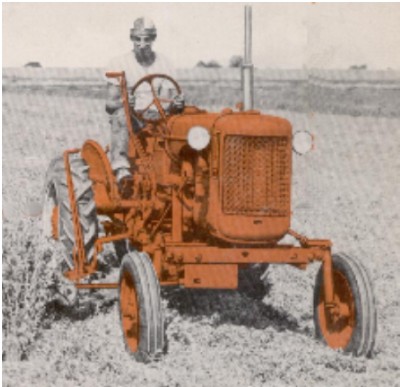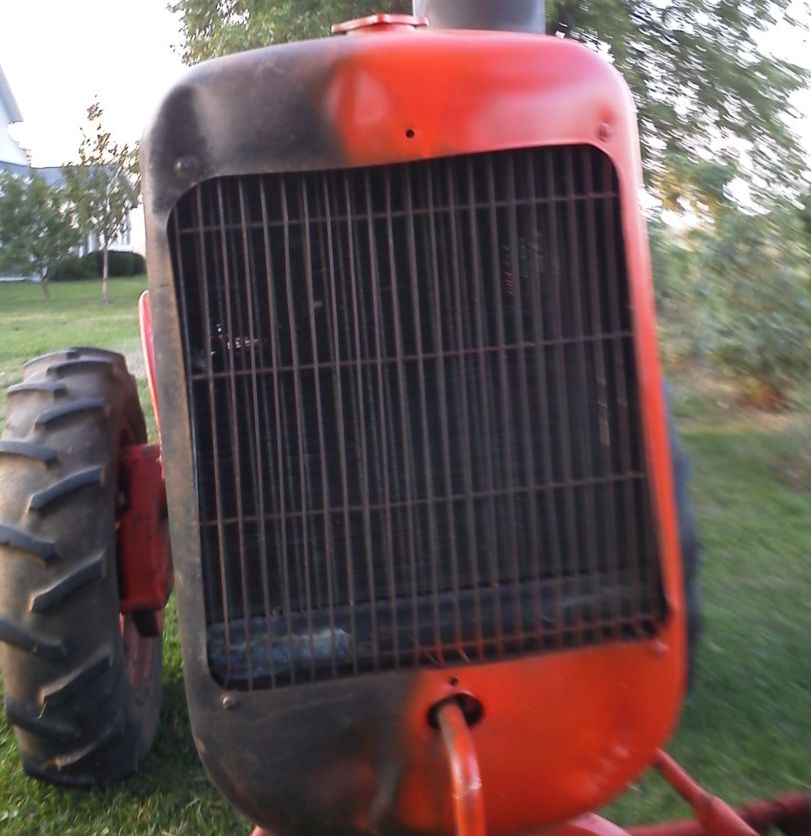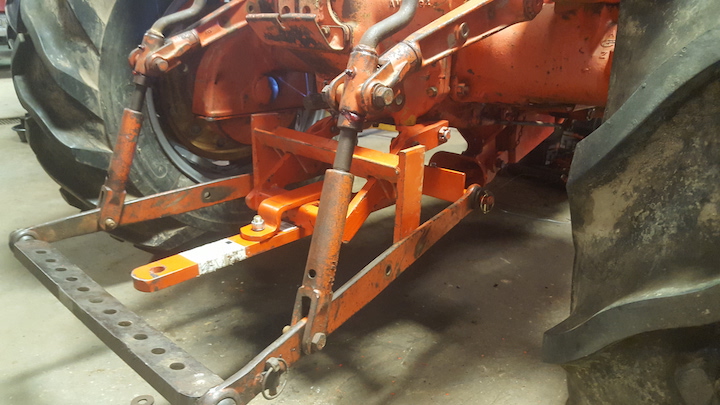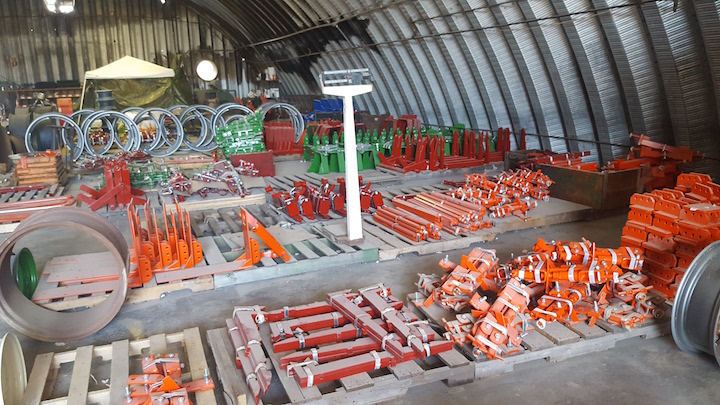| Author |
 Topic Search Topic Search  Topic Options Topic Options
|
Rick of HopeIN 
Orange Level


Joined: 11 Sep 2009
Location: Hope, Indiana
Points: 1329
|
 Post Options Post Options
 Thanks(0) Thanks(0)
 Quote Quote  Reply Reply
 Posted: 15 May 2020 at 9:22am Posted: 15 May 2020 at 9:22am |
|
We had several AC wishbone adapters laying about the farm when I was growing up. In fact I think some always were left on the implement when not in use.
I only occasionally see one in sales, seems like they should be more plentiful but maybe a lot of em got scrapped.
The real 3 point tractors had fixed most of the challenges of hooking up by the sixties. Deere tractors of the 50s already had pull out extensions on the draft arms that let you line up the second ball to hitch up an implement that had settled down unevenly then snap them back in place once you got all three pins in place. I think about all brands had similar features by the sixties.
I remember the snap coupler having its own challenges, the old sickle bar mower would sit in the weeds until late spring and it seems like you always ended up messing around a bit getting on and off the tractor to try and get the bell lined up right. It did not usually go quite like they show in the demonstrations.
Three point hitch geometry that keeps implement at a fixed angle over a range of depths/ heights is better for some attachments, just as the snap coupler pivot point under the tractor is advantage for others. As some mentioned, by variations in top link geometry, the three point setup was pretty versatile.
Slightly different topic, I recently picked up a modern 3 point landscape, box blade for my compact tractor. If you have not tried one I highly recommend for occasional dirt work. Hard to beat the variety of modern attachments that fit three point.
Snap coupler hitch did get a bad rap for the scenario where the snap coupler somehow lets loose while pulling a draft attachment. If the lift arm, latches do not release properly it can allow the attachment to come over the seat. Bad deal. I think some conversions could have possibility of this if they do not use the original lift latches.
Edited by Rick of HopeIN - 15 May 2020 at 10:10am
|
|
1951 B, 1937 WC, 1957 D14, -- Thanks and God Bless
|
 |
|
Sponsored Links
|
|
 |
victoryallis 
Orange Level

Joined: 15 Apr 2010
Location: Ludington mi
Points: 2878
|
 Post Options Post Options
 Thanks(0) Thanks(0)
 Quote Quote  Reply Reply
 Posted: 15 May 2020 at 10:56am Posted: 15 May 2020 at 10:56am |
 DrAllis wrote: DrAllis wrote:
As a 15-16 yr old, dropping the drawbar off of an S4 D-17 was easy. Throwing the whole thing back up in there as one unit was a struggle. It was just about as heavy as a 190XT drawbar. Interesting how the 3-point hitch had to evolve into having a quick hitch on it as it got larger and larger. I think the snap-coupler drawbar/weight issues could have been overcome had it been continued on to bigger tractors. |
The lift latches does sorta resemble the quick hitch idea in a way. I put the drawbar back on as a teen and know as a 40 something year old I could easily do it again on my D17 but no way in he!! would I want to remove the drawbar on my 7580 or 8760. I by far am not an IH guy but I think they had the best idea. I also don’t like the added slop.
|
|
8030 and 8050MFWD, 7580, 3 6080's, 160, 7060, 175, heirloom D17, Deere 8760
|
 |
DennisA (IL) 
Orange Level

Joined: 11 Sep 2009
Location: Ridott IL.
Points: 2074
|
 Post Options Post Options
 Thanks(0) Thanks(0)
 Quote Quote  Reply Reply
 Posted: 15 May 2020 at 2:07pm Posted: 15 May 2020 at 2:07pm |
 victoryallis wrote: victoryallis wrote:
Removing and reinstalling the drawbar on a 17 is a added pain enough imagine on a 300++ horsepower articulated tractor. I’m amazed by the color blindness. |
I'm not being color blind. The snap-coupler is faster and easier to hook up and the pull point is in front of the rear axle which gives the tractor greater pulling ability. I just added a quick-hitch attachment and I can tell already that the pulling performance and lifting capacity have both diminished. You make a good point about the weight of the drawbar. We have a stand that slides under the bail and all you need to do is pull the pins and undo the hook. Everything is kept at the right height so putting it back on is simple. Just back over it put the pins in and hook the hitch back in place, no lifting. Most of my equipment is snap-coupler so I'm not removing and replacing the hitch very often.
|
|
Thanks & God Bless
Dennis
|
 |
FREEDGUY 
Orange Level Access


Joined: 15 Apr 2017
Location: South West Mich
Points: 5396
|
 Post Options Post Options
 Thanks(0) Thanks(0)
 Quote Quote  Reply Reply
 Posted: 15 May 2020 at 5:39pm Posted: 15 May 2020 at 5:39pm |
 victoryallis wrote: victoryallis wrote:
Removing and reinstalling the drawbar on a 17 is a added pain enough imagine on a 300++ horsepower articulated tractor. I’m amazed by the color blindness. |
Why in the #$%K would you need to remove/reinstall a drawbar on your JD tractor ??  Pretty SURE "that" project would be easier than replacing an entire front axle assembly 
|
 |
victoryallis 
Orange Level

Joined: 15 Apr 2010
Location: Ludington mi
Points: 2878
|
 Post Options Post Options
 Thanks(0) Thanks(0)
 Quote Quote  Reply Reply
 Posted: 15 May 2020 at 9:11pm Posted: 15 May 2020 at 9:11pm |
My point was it’s a good thing that snap coupler wasn’t the go to way. The Deere has 3 point had snap coupler been the chosen way it would have been a b!tch to drop the drawbar.
|
|
8030 and 8050MFWD, 7580, 3 6080's, 160, 7060, 175, heirloom D17, Deere 8760
|
 |
John (MO) 
Orange Level

Joined: 16 Sep 2009
Location: NEMO
Points: 202
|
 Post Options Post Options
 Thanks(0) Thanks(0)
 Quote Quote  Reply Reply
 Posted: 15 May 2020 at 9:22pm Posted: 15 May 2020 at 9:22pm |
|
We always just slid 4 big sticks of wood under the drawbar before pulling the pins and driving away. Putting it back on was as simple as backing up to it, little or no lifting involved.
|
 |
jaybmiller 
Orange Level Access

Joined: 12 Sep 2009
Location: Greensville,Ont
Points: 24729
|
 Post Options Post Options
 Thanks(0) Thanks(0)
 Quote Quote  Reply Reply
 Posted: 16 May 2020 at 7:45am Posted: 16 May 2020 at 7:45am |
re:
We always just slid 4 big sticks of wood under the drawbar
yeah, around here , 'someone' would grab 2 of the big sticks for their use..sigh..
|
|
3 D-14s,A-C forklift, B-112
Kubota BX23S lil' TOOT( The Other Orange Tractor)
Never burn your bridges, unless you can walk on water
|
 |
TimNearFortWorth 
Orange Level


Joined: 12 Dec 2009
Points: 2014
|
 Post Options Post Options
 Thanks(0) Thanks(0)
 Quote Quote  Reply Reply
 Posted: 16 May 2020 at 8:24am Posted: 16 May 2020 at 8:24am |
Between the 17IV's, 185 and 190XT, sure the telescoping arms make things easy on 3-pt. hook-up but I tend to use one of the 15's for most anything but tillage and a small cart in the shop makes dropping/installing the OEM adaptor a breeze for SC blade work. I picked up an aluminum "bread cart" years ago and wheels are big enough to use it in the yard if I can't get backed into the shop entrance. If a fella was doing plenty of swapping, 2 carts would be ideal so you can store the draw bar assy. but I tend to grab another tractor for draw bar work; fertilizer buggy, hyd barge wagon, etc. Have a number of "fixed" HD OEM adapters and OEM wishbone type and have used the same wishbone type for many years on cutters as they are darned tough. Keep an eye on swivel points for wear and check the small bushings specifically but I have yet to use the other two adapters that I picked up for spares as the first one is still going strong. The two "backups" are like new as show no wear (no, not for sale!). All depends what you do with them as the wishbone adapters don't have much for sway control and you do need to check the draw bar hanger brackets for wear as the long pin for sway control will egg the brackets eventually. Have used the OEM wishbone type on a heavy 6' cutter for years, literally thousands of hours cutting for both commercial cutting and on my place, upright adjusters can be found at any farm store when they do wear out but I think the main one I use will outlive me. Would I put even a 2-bottom 3-pt. plow on one? Nope, not sufficient sway control. See the OEM adapters pop up occasionally, 150.00 to 350.00.
|
 |
DennisA (IL) 
Orange Level

Joined: 11 Sep 2009
Location: Ridott IL.
Points: 2074
|
 Post Options Post Options
 Thanks(0) Thanks(0)
 Quote Quote  Reply Reply
 Posted: 16 May 2020 at 9:39am Posted: 16 May 2020 at 9:39am |
I really didn’t mean to cause a feud here.
I do like my AC equipment. It’s easy to use, well designed, easy to fix and a joy to use.
I have all AC tractors that range from standard hitch, snap-coupler hitch and 3 point hitch. The tractors that get used the most have the snap-coupler hitch. Why, it’s Not because of color as they are all the same, it’s not because of HP as they are all about the same. It’s because the snap-coupler just works better all around. Easy to attach, the pull point allows the tractor to pull more and better. As for installing the hitch, the past post have addressed that. A simple frame on wheels made by everyday people. Just think how much better if the manufacturer would have supplied a “hitch cart” with each tractor.
As for the snap-coupler being used on the big HP tractors of today. I’m sure that the manufacturers would have designed a way for the hitch to be removed and installed easily. I wouldn’t be surprised if the hitch was just moved out of the way and not totally removed. Maybe even just push a button in the cab. Sad thing is we will never know.
VictoryAllis we just have a difference of opinion which on this subject really doesn’t matter anyway. 3 point won the day and the snap-coupler is passing away. I wish I could buy new snap-coupler equipment but I’m stuck with 3 point so I’m forced to adapt.
|
|
Thanks & God Bless
Dennis
|
 |
DaveKamp 
Orange Level Access


Joined: 12 Apr 2010
Location: LeClaire, Ia
Points: 6081
|
 Post Options Post Options
 Thanks(0) Thanks(0)
 Quote Quote  Reply Reply
 Posted: 16 May 2020 at 8:44pm Posted: 16 May 2020 at 8:44pm |
It is important to realize that the reason WHY there are unique variations of hitching systems between tractors, is because every company had it's own file cabinet of PATENTS.
Harry Ferguson patented his 3-point hitch. Case had EAGLE Hitch... IH had theirs, Allis had SC.
It wasn't until Harry's patent expired that other manufacturers went that way.
The 3-point's 'versatility' came from a few simple concepts- first, is a parallelogram where an implement's physical height could be articulated without affecting it's angle...
But the second, is that it's relative position from a PTO, meant that the PTO shaft of a given implement would be easy to utilize without interference from lifting hardware (that triangular 'window' was 'open for PTO business'
And the third... was that 3-point lifting made it so that SMALL manufacturers of all sorts of power implements need only make it work with 3-point, which had been defined by characteristic dimensions STANDARDIZED for interchangeability.
I built my D17's 3ph... I can use it with or without the drawbar, but it will NOT allow me to snap-couple a plow, as it's a rather stout piece of square tubing under the axle. This causes me no issue, as I don't use the plow... I use a forklift attachment (not a mast, just a face with forks), I use a multi-function hitch (ball, pintle hook, chain hooks, etc.), and (with a quick-hitch) a 10ft lifting boom, a 6ft bush-hog, a post hole auger, and finally, with just the lift arms, a New Holland backhoe attachment.
It wasn't the design of the 3 point hitch that made it a 'de facto' standard it is now... it was the standardization of the 3ph system that enabled proliferation of implement and attachments by non-tractor manufacturers.
It wasn't intended to be 'better' at any one aspect, it was just intended to offer lots of flexibility, which it does very well.
|
|
Ten Amendments, Ten Commandments, and one Golden Rule solve most every problem. Citrus hand-cleaner with Pumice does the rest.
|
 |
Rick of HopeIN 
Orange Level


Joined: 11 Sep 2009
Location: Hope, Indiana
Points: 1329
|
 Post Options Post Options
 Thanks(0) Thanks(0)
 Quote Quote  Reply Reply
 Posted: 17 May 2020 at 9:10am Posted: 17 May 2020 at 9:10am |
|
At the end of the day, the market decides. Three point won out. My ag machinery books from the late 50s show that Deere had decided to go full in on three point hitch. I think they had been doing a little with it already but still had a lot of pull type equipment. Maybe they had decided to pay Ferguson early on, don't know.
Seems about the time that patents were running out, mid to late fifties; The D series had already been designed so Allis stayed with SC to use their existing implement line. Likewise IH would have had to do quite a tear up to switch from fast hitch.
The argument about line of draft to the snap coupler bell under the tractor was mostly marketing hype from the SC and IH Fasthitch days. They were a natural design progression from pull type implement designs.
As hydraulic draft control/ lift systems came into play it was actually better to have the parallelogram setup of the three point with it's adjustability/ control features integrated into the tractor. With larger, semi mounted plows a lot of the design considerations that drove the earlier systems had already changed. The Case Eagle Claw was a very minor variant of the three point if it is like what we had on an 1963 730. Our 1965 Case 730 had standard three point lift arms and any three point would fit either.
I grew up in the last years of moldboard plows in the Midwest. The pull type plows had been retired. Three point (actually using only the lower arms), semi mounted plows had taken over around us. Four of five bottom plows that just were a joy to run. Seems like we would check the depth early in the spring and never messed with em after.
Edited by Rick of HopeIN - 17 May 2020 at 9:12am
|
|
1951 B, 1937 WC, 1957 D14, -- Thanks and God Bless
|
 |
Strokendiesel002 
Silver Level


Joined: 04 Apr 2019
Location: 53158
Points: 252
|
 Post Options Post Options
 Thanks(0) Thanks(0)
 Quote Quote  Reply Reply
 Posted: 17 May 2020 at 9:26am Posted: 17 May 2020 at 9:26am |
|
Thank you again for all the suggestions and experiences!
Lots to think about
|
 |
DaveKamp 
Orange Level Access


Joined: 12 Apr 2010
Location: LeClaire, Ia
Points: 6081
|
 Post Options Post Options
 Thanks(0) Thanks(0)
 Quote Quote  Reply Reply
 Posted: 17 May 2020 at 11:38am Posted: 17 May 2020 at 11:38am |
While ultimately, 'markets decide'... it is the course of history which decides WHEN 'markets' may decide. It is not a simple condition of 'black and white', and in the realm of agricultural equipment development from 1920 through the present, the greatest 'market battleground' occurred between legal departments, courtrooms, and patent offices over 'intellectual property rights'.
Harry developed his 3-point prior to 1921... received his US patent in 1926. That patent, and the ancillary re-patenting maintained substantial strength up to about 1959/60.
EVERY COMPANY had it's files of patents. Any company that infringed on another company's patent, or even came CLOSE, was at risk of legal action, and there was LOTS of legal action.
I noted the other types of hitches, because, along with patents, were included trademarks and copywright. None of this made a hoot of difference to the farmer and his soil, but it TOTALLY affected how, and when, a standardization occurred.
It was in the best interest of EVERY manufacturer, to constantly apply for patents. Companies came up with concepts, and applied for patents EVEN WHEN they had NO INTENTION of using the concept. Why? Because if some OTHER company built something that used a simililar principle, they could either BLOCK it's production, or demand royalty and license revenue.
It was not unusual for someone to perform 'industrial espionage' on another company's development department, and as soon as they saw something, race off, draw a sketch, and apply for a patent.
Dirty? Yep. Illegal? Nope. Oh, and once a patent was granted, it meant absolutely NOTHING... until you sent lawyers out to investigate others, and file infringement suits.
Harry's patents weren't fully expired when other companies started designing their lifting systems. Ever wonder why so many 'branded' hitching systems were so similar? Because they could get-that-close without being beaten in a courtroom...
And manufacturers KNEW that once the Eagle, or the Snap Coupler setup was in a farmer's hands, they would MAKE the remaining pieces to give what they wanted... OR, the AFTERMARKET would do it... thus isolating the manufacturer from patent infringement action. Very often, a small manufacturer was SO small, that an infringement suit would yield no profit from enforcement (it'd cost the patent holder more than the cost of suit), and the judgement would be unpaid (aftermarket manufacturer bankrupted). The eventual reality is that, like a war, there's significant financial casualties on both sides, the small guys are smothered, but the large guys have burned up all their resources fighting a legal war of attrition, and in the end, weakened themselves beyond recovery.
The market doesn't exactly 'decide'.
There's good ideas in EVERY hitching system, always based on the application and circumstance. What became 'the most popular', did not automatically become the 'universal'. As noted by others above, the hitching point of other systems, placing the pivot of draft load AHEAD of, and BELOW the axle, provides much better stability in a ground-engaging application.
The laws of physics cannot be violated, and farmers don't have the liberty to make insensible decisions. My neighbor has an 8-wheel articulated, and two 6-wheel conventional tractors. He pulls some amazing heavy tillage, prep, and planting equipment, and not a single one of those implements are on a 3-point... they're on drawbars. When he runs his spot spray rig, it's on 3 point, using a quick-hitch.
It all comes down to doing what's most necessary for an application's demands.
|
|
Ten Amendments, Ten Commandments, and one Golden Rule solve most every problem. Citrus hand-cleaner with Pumice does the rest.
|
 |
modirt 
Orange Level Access


Joined: 18 Jul 2018
Location: Missouri
Points: 8812
|
 Post Options Post Options
 Thanks(0) Thanks(0)
 Quote Quote  Reply Reply
 Posted: 18 May 2020 at 8:13am Posted: 18 May 2020 at 8:13am |
Back to OP's question, the factory 3 point on the D15 Series II that currently resides under my stewardship was found to have been busted, repaired, and busted again. Gave up on that and converted hitch back to snap coupler, with Cross Manufacturing conversion kit.
We were able to retain the original factory 3 point lift arms, so about as good of a solution as I could imagine. I have NO snap coupler attachments, so wasn't an issue for me.
Have concluded this conversion setup to be far more robust than the original factory 3 point was.
I went to the factory to pick mine up, but OK tractor sells the same thing.
|
 |
200Tom1 
Orange Level


Joined: 03 Jun 2019
Location: Iowa
Points: 1232
|
 Post Options Post Options
 Thanks(0) Thanks(0)
 Quote Quote  Reply Reply
 Posted: 10 Jun 2023 at 8:10am Posted: 10 Jun 2023 at 8:10am |
|
I hope you don't come to detest it as much as I did with the one on my series 4. After 20+ years I finally found a factory 3 point off a 170 and I sold the aftermarket. The factory 3 point made a real nice tractor out of my series 4 diesel.
|
 |
DrAllis 
Orange Level Access

Joined: 12 Sep 2009
Points: 22024
|
 Post Options Post Options
 Thanks(0) Thanks(0)
 Quote Quote  Reply Reply
 Posted: 10 Jun 2023 at 6:13pm Posted: 10 Jun 2023 at 6:13pm |
|
It's always annoyed me when the add-on 3 point hitches didn't have the extendable lower links (like OEM hitches Cat #2) to hook up to things easier.
|
 |









 Topic Options
Topic Options

 Post Options
Post Options Thanks(0)
Thanks(0)


 DrAllis wrote:
DrAllis wrote:




